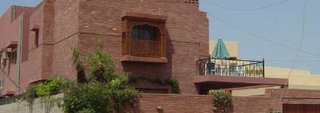By David Montero, Correspondent of The Christian Science Monitor Tue Oct 24, 4:00 AM ET
KARACHI, PAKISTAN - When he started his software company, Omar Malik wasn't thinking about social responsibility - let alone changing society.
He wanted to make a bundle in Pakistan's exploding service sector, he readily admits. But now, eight years later, he's seen what a difference his company makes in the lives of his 35 employees, most of them educated at local universities. For Mr. Malik, a graduate of Georgetown University in Washington, business has an underlying social mission.
"Even if you come from a lower class background, you will, through companies like ours, be able to get better opportunities," says Malik, whose Lahore-based firm, Trisoft Technology, develops software for clients as diverse as the government of Punjab and a semiconductor firm in Dallas, Texas.
Service sector businesses like Trisoft are exploding in Pakistan, reaching record growth this year and accounting for half the country's gross domestic product. They've helped the economy grow so fast - 8.4 percent in 2005 - that some are calling it one of Asia's hottest.
While such a rapid explosion of wealth among Pakistan's elite has raised concerns about a parallel explosion in social inequality, Malik is part of a wave of young entrepreneurs who see an emerging antidote: their businesses. By creating jobs for young people and exportable products that promote stability, they reason, they can give Pakistanis viable alternatives to extremism.
"How many people who have jobs would actually go to their employer and say, 'There's a protest. I'm going to go burn some American flags'?" asks Shakir Hussain, a Whittier College graduate who employs 45 people at his software-consulting business in Karachi.
And not only would such jobs keep youth away from violent activities - it could also help project a different face of Pakistan to the world and vice versa, young entrepreneurs say. American clients constitute the bulk of business for both Malik and Mr. Hussain.
Nearly every day their staffs interact via phone and e-mail with counterparts in the US or other Western countries. For most, it's the only time in their lives they would interact, and those interchanges are helping erase misconceptions on both sides.
"[My employees] realize, 'Hey, these people are exactly like us. They don't bring up politics and religion every time. There is no agenda,' " says Malik.
Cross-cultural currents are increasingly common in the country's new economy, which has by most accounts undergone a dramatic turnaround in recent years. In 1998, when it was bogged down with sanctions after detonating a nuclear bomb, the country was close to defaulting on its foreign loans; today Standard and Poor's gives it a B+ rating.
Economic liberalization has helped blaze that path, but so too, has 9/11. In a bid to win Pakistan's support in the war on terror following the attack, the US canceled $1.5 billion in debt. Remittances sent by expat Pakistanis jumped from $1.5 billion in 2001 to $4 billion last year. Many expats came with their capital, helping to spur real estate and stock market booms.
The government likes to brag that the dividends of growth are already trickling down. Poverty has fallen from 34.5 percent in 2001 to 23.3 percent in 2005, according to the Asian Development Bank, it points out. "Wherever you go you see traffic jams. This is a good thing to have. People are buying cars and automobiles," says Ashfaq Hassan Khan, an economic adviser to the finance ministry.
Not everyone agrees, however. Instead, there is a national debate as to whom Pakistan's new wealth is actually benefiting.
"If you look at where a lot of the money's being made, it's real estate and the stock market. And that's benefited few people," says Hussain. The employees at his business, Creative Chaos, come mainly from local universities typically attended by lower- and middle- class students. Hussain admits his staff is certainly not representative of the poorest of the poor. But he sees his business as a start to luring less privileged young people into a rapidly expanding industry. In the coming months his company will host a scholarship program to encourage this trend.
It's a vital effort, say some analysts, who see a storm brewing on the horizon. Wealth is increasing, but it's controlled by the upper classes, says Kaiser Bengali, a Karachi-based economist.
Mr. Bengali and others are worried that the economic expansion is only exacerbating disparities that lead to extremism, among other things. Unemployment has improved, falling from 8.3 percent in 2002 to 6.5 percent in the first half of 2006, according to the Asian Development Bank. But without the prospect of new industries where they can find jobs, analysts say, young people are susceptible to the lures of radical groups, who provide support and a sense of purpose.
"[Extremism] has an economic solution," says Mr. Khan, the economic adviser. "If you reduce the amount of inequality, you will remove the sources of extremism," says Bengali. It's a position Washington would like to bolster by beefing up small businesses. In August, the United States Agency for International Development (USAID) signed an agreement with the Pakistani government granting $17.3 million to be used in part for 130,000 loans to small and micro businesses.
While young entrepreneurs are optimistic about their country's progress, they also know they can't just sit back and enjoy the spoils.
"[T]here's a possibility that the country can get out of the stagnant position it's in," says Umair Aziz, Hussain's business partner, who worked for a software company in Boston for several years before returning to Pakistan. "It's people like us ... who can make that change possible."
http://news.yahoo.com/s/csm/20061024/wl_csm/odynamo



























